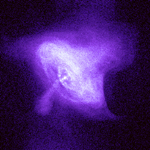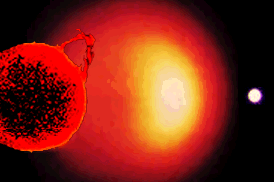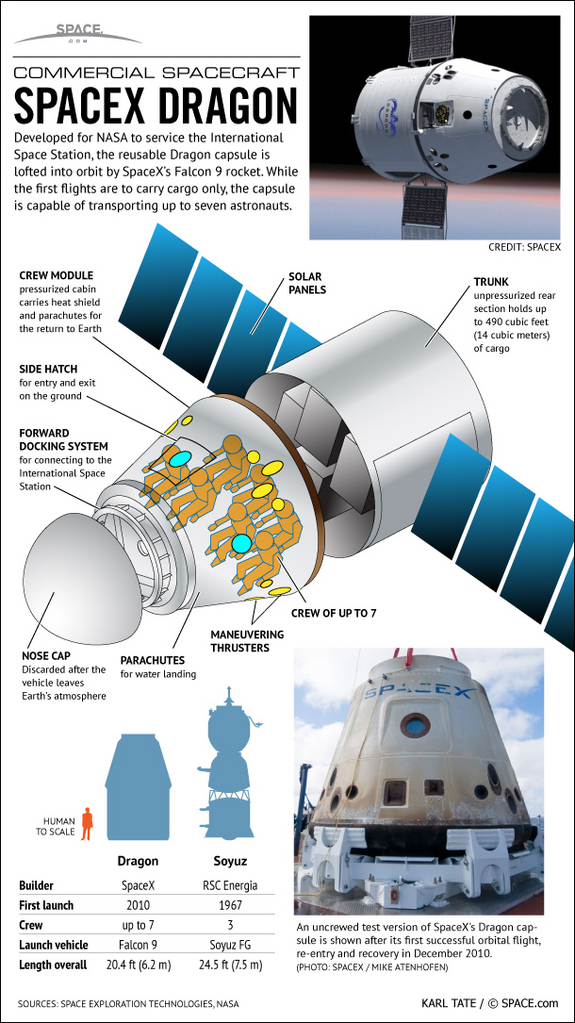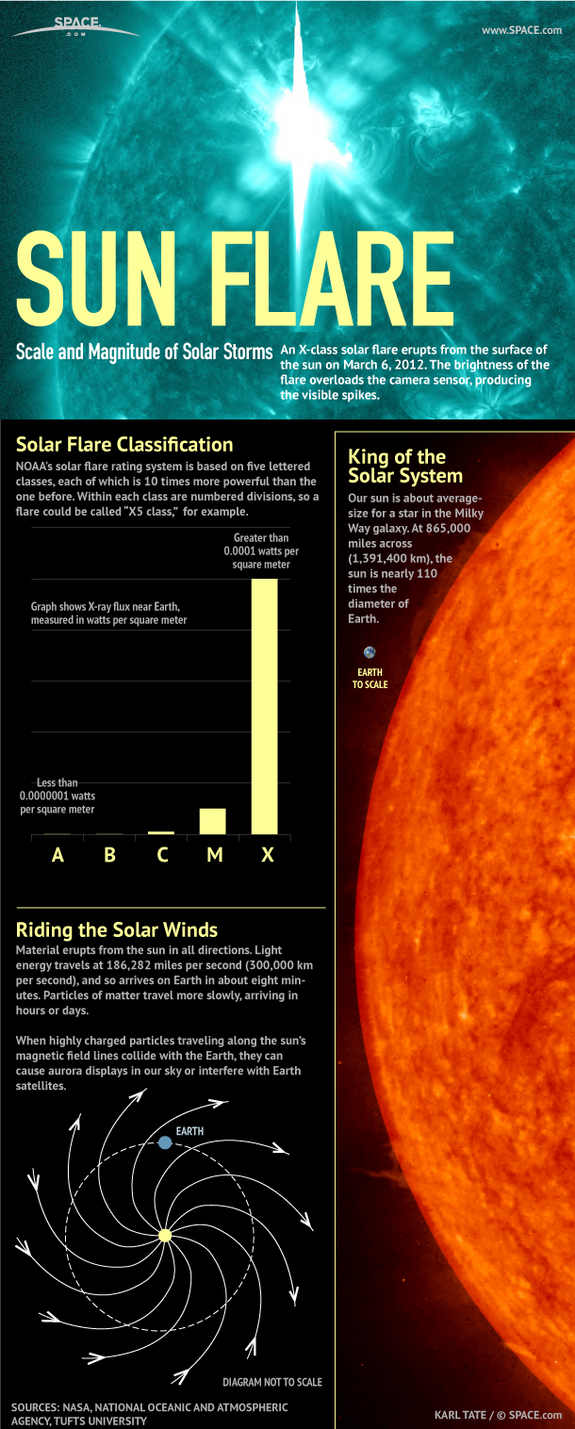Q115: Which is nearest galaxy to the milky-way galaxy?
Wednesday, October 31, 2012
Answer to Question 114
A114: Our Milky Way galaxy is a 'Barred Spiral', type SBc.
Edwin Hubble classified these types of spiral galaxies as "SB" ("Spiral", "Barred") in his Hubble sequence, and arranged them into three sub-categories based on how open the arms of the spiral are.
SBa types feature tightly bound arms.
SBc types are at the other extreme and have loosely bound arms.
SBb type galaxies lie in between.
SBm, was subsequently created to describe somewhat irregular barred spirals, such as the Magellanic Cloud galaxies, which were once classified as irregular galaxies, but have since been found to contain barred spiral structures.
NASA Lunar Scientists Develop New Theory on Earth and Moon Formation
This new theory about how Earth’s moon formed is challenging the commonly believed “giant impact hypothesis,” which suggests that Earth's moon formed from a colossal impact of a hypothetical planetary embryo, named Theia, with Earth, early in our Solar System's history.
Crew Preparing for Cargo Ship, Spacewalk
The Expedition 33 crew of the International Space Station spent Tuesday gearing up for Wednesday’s arrival of a Russian cargo craft and Thursday’s spacewalk to repair an ammonia leak.
The ISS Progress 49 cargo vehicle is scheduled to launch from the Baikonur Cosmodrome in Kazakhstan at 3:41 a.m. EDT Wednesday, docking to the aft end of the station’s Zvezda service module at 9:40 a.m. Progress 49 is delivering 2.9 tons of supplies to the orbiting complex, including 2,050 pounds of propellant, 62 pounds of oxygen, 42 pounds of air, 926 pounds of water and 2,738 pounds of spare parts, experiment hardware and maintenance equipment.
If any technical issues arise, the Russian flight control team may default to a two-day rendezvous plan that would result in docking on Friday.
NASA Television coverage of the launch begins at 3:15 a.m. Wednesday and resumes at 9 a.m. for the rendezvous and docking.
Source: NASA
NASA Rover's First Soil Studies Help Fingerprint Martian Minerals
NASA's Mars rover Curiosity has completed initial experiments showing the mineralogy of Martian soil is similar to weathered basaltic soils of volcanic origin in Hawaii.
The minerals were identified in the first sample of Martian soil ingested recently by the rover. Curiosity used its Chemistry and Mineralogy instrument (CheMin) to obtain the results, which are filling gaps and adding confidence to earlier estimates of the mineralogical makeup of the dust and fine soil widespread on the Red Planet.
Curiosity Digs In
This pair of images shows a "bite mark" where NASA's Curiosity rover scooped up some Martian soil (left), and the scoop carrying soil. The first scoop sample was taken from the "Rocknest" patch of dust and sand on Oct. 7, 2012, the 61st sol, or Martian day, of operations. A third scoop sample was collected on Oct. 15, or Sol 69, and deposited into the Chemistry and Mineralogy (CheMin) instrument on Oct. 17, or Sol 71.
Wind-Blown Martian Sand
This pair of images from the Mast Camera on NASA's Curiosity rover shows the upper portion of a wind-blown deposit dubbed "Rocknest." The rover team recently commanded Curiosity to take a scoop of soil from a region located out of frame, below this view. The soil was then analyzed with the Chemistry and Mineralogy instrument, or CheMin.
First X-ray View of Martian Soil
This graphic shows results of the first analysis of Martian soil by the Chemistry and Mineralogy (CheMin) experiment on NASA's Curiosity rover. The image reveals the presence of crystalline feldspar, pyroxenes and olivine mixed with some amorphous (non-crystalline) material. The soil sample, taken from a wind-blown deposit within Gale Crater, where the rover landed, is similar to volcanic soils in Hawaii.
Tuesday, October 30, 2012
Answer to Question 113
A113: An equator is the intersection of a sphere's surface with the plane perpendicular to the sphere's axis of rotation and containing the sphere's center of mass. Notably, the Equator refers to the Earth's equator, per above: an imaginary line on the Earth's surface equidistant from the North Pole and South Pole, dividing the Earth into the Northern Hemisphere and Southern Hemisphere. Other planets and spherical astronomical bodies have equators similarly defined. The length of the Equator is roughly 40,075 kilometres (24,901 mi).
Source:Wiki
Mars Odyssey: Record-Breaking Mission to Mar
NASA's Mars Odyssey spacecraft passes above Mars' south pole in this artist's concept illustration. The spacecraft has been orbiting Mars since October 24, 2001. The spacecraft serves as a vital relay for NASA's Mars rover Curiosity.
For more than a decade, Mars Odyssey has been circling the Red Planet. The NASA spacecraft broke a record in 2010 for being the longest-serving piece of machinery to work at Mars.
Rock 'Et-Then' Near Curiosity, Sol 82
The Mars Hand Lens Imager (MAHLI) on the arm of NASA's Mars rover Curiosity took this image of a rock called "Et-Then" during the mission's 82nd sol, or Martian day (Oct. 29, 2012.)
The rock's informal name comes from the name of an island in Great Slave Lake, Northwest Territories, Canada.
MAHLI viewed the rock from a distance of about 15.8 inches (40 centimeters). The image covers an area about 9.5 inches by 7 inches (24 centimeters by 18 centimeters). Et-Then is located near the rover's front left wheel, where the rover has been stationed while scooping soil at the site called "Rocknest."
This is one of three images acquired by MAHLI from slightly different positions so that a three-dimensional information could be used to plan possible future examination of the rock.
Image credit: NASA/JPL-Caltech/MSSS
Monday, October 29, 2012
Answer to Question 112
Q112: In the theory of relativity, time dilation is an actual difference of elapsed time between two events as measured by observers either moving relative to each other or differently situated from gravitational masses.
Bright Particle in Hole Dug by Scooping of Martian Soil
This image shows part of the small pit or bite created when NASA's Mars rover Curiosity collected its second scoop of Martian soil at a sandy patch called "Rocknest." The bright particle near the center of this image, and similar ones elsewhere in the pit, prompted concern because a small, light-toned shred of debris from the spacecraft had been observed previously nearby (PIA16230). However, the mission's science team assessed the bright particles in this scooped pit to be native Martian material rather than spacecraft debris.
Dragon's Return
The SpaceX Dragon cargo craft spashed down in the Pacific Ocean at 3:22 p.m. EDT Sunday about 250 miles off the coast of Baja California, Mexico, marking a successful conclusion to the first contracted resupply mission to the International Space Station.
The Dragon capsule will be taken by boat to a port near Los Angeles, where it will be prepared for a return journey to SpaceX's test facility in McGregor, Texas, for processing. Some cargo will be removed at the port in California and returned to NASA within 48 hours. This includes a GLACIER freezer packed with research samples collected in the orbiting laboratory's unique microgravity environment. These samples will help advance multiple scientific disciplines on Earth and provide critical data on the effects of long-duration spaceflight on the human body. The remainder of the cargo will be returned to Texas with the capsule.
Sunday, October 28, 2012
Crew Releases Dragon for Return to Earth
The SpaceX Dragon cargo craft maneuvers away from the International Space Station. Credit: NASA TV
The SpaceX Dragon cargo craft was released from the International Space Station’s robotic arm by the Expedition 33 crew at 9:29 a.m. EDT. Dragon will perform three burns to place it on a trajectory away from the station and begin its return trip to Earth.
Saturday, October 27, 2012
Answer to Question 111
A supernova remnant (SNR) is the remains of a supernova explosion. SNRs are extremely important for understanding our galaxy. They heat up the interstellar medium, distribute heavy elements throughout the galaxy, and accelerate cosmic rays.
| Two Sample Supernova Remnants | |
|---|---|
 |  |
| Cygnus Loop in X-rays | Crab Nebula in X-rays |
Video: How Mercury, Venus, Earth, And Mars Formed
The rocky, metallic worlds of the inner solar system look quite different from those of the outer solar system, one theory supposes they formed in much the same way. However, a competing theory suggests they may have formed from different components.
SOURCE: SPACE.com
SOURCE: SPACE.com
NASA's STEREO (with SDO) sees the entire sun
On the evening of Oct. 25, 2006, the twin Solar Terrestrial Relations Observatory (STEREO) spacecraft launched into space, destined for fairly simple orbits: both circle the sun like Earth does, STEREO-A traveling in a slightly smaller and therefore faster orbit, STEREO-B traveling in a larger and slower orbit. Those simple orbits, however, result in interesting geometry. As one spacecraft gained an increasing lead over Earth, the other trailed further and further behind. In February of 2011, each STEREO spacecraft was situated on opposite sides of the sun, and on Sept. 1, 2012, the two spacecraft and and the Solar Dynamics Observatory (at Earth) formed an equal-sided triangle, with each observatory providing overlapping views of the entire sun.
STEREO Reaches New Milestone At Its Sixth Anniversary
Each of these images was captured from a different perspective by one of NASA's Solar Terrestrial Relations Observatory (STEREO) spacecraft on Oct. 14, 2012. The image on the left, STEREO-B, shows a dark vertical line slightly to the upper left of center. Only by looking at the image on the right, captured by STEREO-A from a different direction, is this feature revealed to be a giant prominence of solar material bursting through the sun's atmosphere. Credit: NASA/STEREO
Hubble Sees Violent Star Formation Episodes in Dwarf Galaxies
The NASA/ESA Hubble Space Telescope has imaged the faint irregular galaxy NGC 3738, a starburst galaxy. The galaxy is in the midst of a violent episode of star formation, during which it is converting reservoirs of hydrogen gas located in the galaxy’s center into stars. Hubble spots this gas glowing red around NGC 3738, one of the most distinctive signs of ongoing star formation.
Friday, October 26, 2012
Space art competition for kids
More art and science are colliding! The Lunar and Planetary Institute is hosting the Humans in Space Youth Art Competition. Kids from anywhere in the world ages 10 – 18 are encouraged to express their feelings about human spaceflight using "…visual, literary, musical and video artwork".
I’m a big supporter of scientific art, and I think this is a great idea. If you’re that age, or know someone who is, let them know! The deadline for submitting the work is midnight U.S. Central Standard Time, November 15, 2012. The website has the details.
NASA Space Settlement Contest
This annual contest, co-sponsored by NASA Ames and the National Space Society (NSS) is for all students up to 12th grade (18 years old) from anywhere in the world. Individuals, small teams of two to six, and large teams of seven or more are judged separately. Entries are also grouped by age/grade of the oldest contestant for judging. The age groups are 7th and under, 8th, 9th, 10th, 11th and 12th. The grand prize is awarded to the best entry regardless of contestant age. Students develop space settlement designs and related materials. These are sent to NASA Ames for judgement. Submissions must be received by March 15, 2013. For more detail: http://settlement.arc.nasa.gov/Contest/
NASA-WPI 2013 Robot Prize Competition Registration Open
NASA and the Worcester Polytechnic Institute (WPI) in
Worcester, Mass., have opened registration and are seeking teams to compete in
next year's robot technology demonstration competition, which offers as much as
$1.5 million in prize money.
Super-Dense Neutron Star Is Fastest Ever Seen
This artist's impression shows the speedy companion (right) as it races around the pulsar PSR J1311-3430 (left). The energetic gamma-radiation emitted by the pulsar heats and consequently evaporates the companion. The pulsar, which completes one orbit every 93 minutes, is surrounded by its strong magnetic field (blue).
CREDIT: NASA/DOE/Fermi LAT Collaboration/AEI
Assessing Drop-Off to Mars Rover's Observation Tray
NASA's Mars rover Curiosity used its Mast Camera (Mastcam) during the mission's 78th sol (Oct. 24, 2012) to view soil material on the rover's observation tray. The observations will help assess movement of the sample on the tray in response to vibrations from sample-delivery and sample-processing activities of mechanisms on the rover's arm.
Sample material from the fourth scoop of Martian soil collected by NASA's Mars rover Curiosity is on the rover's observation tray in this image taken during the mission's 78th Martian day, or sol, (Oct. 24, 2012) by Curiosity's left Navigation Camera. The tray is 3 inches (7.8 centimeters) in diameter. Image credit: NASA/JPL-Caltech
Video - Saturn's Monster Storm Blasted Stratosphere With Extreme Heat
The massive storm on Saturn from January 2011 to March 2012 triggered powerful discharges that sent temperatures up to 150 degrees Fahrenheit above normal. NASA's Cassini spacecraft was on hand to capture the outburst in infrared.
Source: SPACE.com and NASA
New Study Brings a Doubted Exoplanet 'Back from the Dead'
A second look at data from NASA's Hubble Space Telescope is reanimating the claim that the nearby star Fomalhaut hosts a massive exoplanet. The study suggests that the planet, named Fomalhaut b, is a rare and possibly unique object that is completely shrouded by dust.
Fomalhaut is the brightest star in the constellation Piscis Austrinus and lies 25 light-years away.
In November 2008, Hubble astronomers announced the exoplanet, named Fomalhaut b, as the first one ever directly imaged in visible light around another star. The object was imaged just inside a vast ring of debris surrounding but offset from the host star. The planet's location and mass -- no more than three times Jupiter's -- seemed just right for its gravity to explain the ring's appearance.
NASA Spacecraft Sees Huge Burp at Saturn After Large Storm
NASA's Cassini spacecraft has tracked the aftermath of a rare massive storm on Saturn. Data reveal record-setting disturbances in the planet's upper atmosphere long after the visible signs of the storm abated, in addition to an indication the storm was more forceful than scientists previously thought.
These red, orange and green clouds (false color) in Saturn's northern hemisphere indicate the tail end of the massive 2010-2011 storm. Even after visible signs of the storm started to fade, infrared measurements continued to reveal powerful effects at work in Saturn's stratosphere. (Credit: NASA/JPL-Caltech/Space Science Institute)
Thursday, October 25, 2012
Answer to Question 109
A109: A planetary nebula is a nebula that is made up of gas and plasma. They are made by certain types of stars when they die. They are named this because they look like planets through small optical telescopes.They do not last for very long compared to a star, only tens of thousands of years.
Mercury at Its Best Now for Southern Stargazers
The sky at sunset as seen from the Southern Hemisphere, in this case Melbourne Australia. Mercury is at its best this week, joining Mars, Antares, and Alpha and Beta Centauri.
CREDIT: Starry Night Software
The planet Mercury is one of the brightest objects in the sky, but the elusive rocky world is always a challenge to observe, though it is a prime target for planet-seeking observers in the Southern Hemisphere.
Because Mercury orbits close to our sun, it never strays far from the sun's bright glow. Even when it is farthest from the sun, as it is this week, Mercury's position in the sky often makes it difficult to see.
NASA's Spitzer Sees Light of Lonesome Stars
The image on the left shows a portion of our sky, called the Boötes field, in infrared light, while the image on the right shows a mysterious, background infrared glow captured by NASA's Spitzer Space Telescope in the same region of sky. Image credit: NASA/JPL-Caltech/Carnegie
A new study using data from NASA's Spitzer Space Telescope suggests a cause for the mysterious glow of infrared light seen across the entire sky. It comes from isolated stars beyond the edges of galaxies. These stars are thought to have once belonged to the galaxies before violent galaxy mergers stripped them away into the relatively empty space outside of their former homes.
Spitzer Sees Stray Starlight (Artist's Concept)
New research from scientists using NASA's Spitzer Space Telescope suggests that a mysterious infrared glow across our whole sky is coming from stray stars torn from galaxies. When galaxies grow, they merge and become gravitationally tangled in a violent process that results in streams of stars being ripped away from the galaxies. Such streams, called tidal tails, can be seen in this artist's concept. Scientists say that Spitzer is picking up the collective glow of stars such as these, which linger in the spaces between galaxies.
This artwork is adapted, in part, from galaxy images obtained from the NASA/ESA Hubble Space Telescope.
Image credit: NASA/JPL-Caltech
NASA Study Using Cluster Reveals New Insights Into Solar Wind
When the interplanetary magnetic field (IMF) is oriented westward (dawnward) or eastward (duskward), magnetopause boundary layers at higher latitude become most subject to Kelvin–Helmholtz instabilities — shown here in an artist’s representation as giant swirls. Credit: AOES Medialab
A new study based on data from European Space Agency’s Cluster mission shows that it is easier for the solar wind to penetrate Earth’s magnetic environment, the magnetosphere, than had previously been thought. Scientists from NASA's Goddard Space Flight Center in Greenbelt, Md. have, for the first time, directly observed the presence of certain waves in the solar wind—called Kelvin-Helmholtz waves that can help transfer energy into near-Earth space—under circumstances when previous theories predicted they were not expected.
Wednesday, October 24, 2012
Answer to Question 108
A white dwarf is what stars like the Sun become after they have exhausted their nuclear fuel. Near the end of its nuclear burning stage, this type of star expels most of its outer material, creating a planetary nebula. Only the hot core of the star remains. This core becomes a very hot white dwarf, with a temperature exceeding 100,000 Kelvin. Unless it is accreting matter from a nearby star , the white dwarf cools down over the next billion years or so. Many nearby, young white dwarfs have been detected as sources of soft, or lower-energy, X-rays. Recently, soft X-ray and extreme ultraviolet observations have become a powerful tool in the study the composition and structure of the thin atmosphere of these stars.
 |
First Look at Milky Way's Monster in High-Energy X-ray Light
Image credit: NASA/JPL-Caltech
These are the first, focused high-energy X-ray views of the area surrounding the supermassive black hole, called Sagittarius A*, at the center of our galaxy. The images were taken by NASA's black-hole hunter, the Nuclear Spectroscopic Telescope Array, or NuSTAR. Different X-ray energies have been assigned colors to make the composite images shown here.
NASA's NuSTAR Spots Flare From Milky Way's Black Hole
NASA's newest set of X-ray eyes in the sky, the Nuclear Spectroscopic Telescope Array (NuSTAR), has caught its first look at the giant black hole parked at the center of our galaxy. The observations show the typically mild-mannered black hole during the middle of a flare-up.
"We got lucky to have captured an outburst from the black hole during our observing campaign," said Fiona Harrison, the mission's principal investigator at the California Institute of Technology (Caltech) in Pasadena. "These data will help us better understand the gentle giant at the heart of our galaxy and why it sometimes flares up for a few hours and then returns to slumber."
NASA's Nuclear Spectroscopic Telescope Array, or NuSTAR, has captured these first, focused views of the supermassive black hole at the heart of our galaxy in high-energy X-ray light. Image credit: NASA/JPL-Caltech
Quasar May Be Embedded in Unusually Dusty Galaxy
This is a Hubble Space Telescope view of one of the most distant and luminous quasars ever seen (circled in white) and dates to less than one billion years after the big bang. This near-infrared light image was taken with Hubble's Wide Field Camera 3 in December 2010 and January 2011. (Credit: NASA/ESA/M. Mechtley, R. Windhorst, Arizona State
Hubble astronomers have looked at one of the most distant and brightest quasars in the universe and are surprised by what they did not see: the underlying host galaxy of stars feeding the quasar. The best explanation is that the galaxy is shrouded in so much dust that the stars are completely hidden everywhere. Astronomers believe that the James Webb Space Telescope will reveal the galaxy.
Tuesday, October 23, 2012
Answer to Question 107
A107:
 Neutron stars are fascinating objects because they are the most dense objects known. They are only about 10 miles in diameter, yet they are more massive than the Sun. One sugar cube of neutron star material weighs about 100 million tons, which is about as much as a mountain.
Neutron stars are fascinating objects because they are the most dense objects known. They are only about 10 miles in diameter, yet they are more massive than the Sun. One sugar cube of neutron star material weighs about 100 million tons, which is about as much as a mountain.
Neutron stars are compact objects that are created in the cores of massive stars during supernova explosions. The core of the star collapses, and crushes together every proton with a corresponding electron turning each electron-proton pair into a neutron. The neutrons, however, can often stop the collapse and remain as a neutron star.
 Neutron stars are fascinating objects because they are the most dense objects known. They are only about 10 miles in diameter, yet they are more massive than the Sun. One sugar cube of neutron star material weighs about 100 million tons, which is about as much as a mountain.
Neutron stars are fascinating objects because they are the most dense objects known. They are only about 10 miles in diameter, yet they are more massive than the Sun. One sugar cube of neutron star material weighs about 100 million tons, which is about as much as a mountain.
Like their less massive counterparts, white dwarfs, the heavier a neutron star gets the smaller it gets. Imagine if a 10 pound bag of flour was smaller than a 5 pound bag!
Neutron stars can be observed occasionally, as with Puppis A above, as an extremely small and hot star within a supernova remnant. However, they are more likely to be seen when they are a pulsar or part of an X-ray binary.
Source: NASA
Video: Soyuz TMA-06M spacecraft & rocket are rolled out to the launch pad
The Soyuz TMA-06M spacecraft & rocket are rolled out to the launch pad at site 31 at Baikonur Cosmodrome in Kazakhstan. NASA astronaut Kevin Ford, & Russian cosmonauts Oleg Novitskiy & Evgeny Tarelkin, are set to launch aboard the Soyuz on the ISS.
Source: SPACE.com
Soyuz rocket is ready to be erected into position
The Soyuz rocket is ready to be erected into position after being rolled out to the launch pad by train, on Sunday, October 21, 2012, at the Baikonur Cosmodrome in Kazakhstan. Launch of the Soyuz rocket is scheduled for October 23 and will send Expedition 33/34 Flight Engineer Kevin Ford of NASA, Soyuz Commander Oleg Novitskiy and Flight Engineer Evgeny Tarelkin of ROSCOSMOS on a five-month mission aboard the International Space Station.
CREDIT: NASA
Soyuz Rocket Launching US-Russian Crew to Space Station Tuesday
The three members of Expedition 33 pose wearing their spacesuits in front of the Soyuz capsule that will transport them to the International Space Station. L to R: American astronaut Kevin Ford (of NASA), Soyuz Commander Oleg Novitskiy, Flight Engineer Evgeny Tarelkin. Image released Oct. 10, 2012.
CREDIT: S.P. Korolev RSC "Energia"
A Soyuz rocket is counting down to launch a new U.S.-Russian crew to the International Space Station on Tuesday (Oct. 23), a mission that will double the orbiting laboratory's population.
A New Set of Solar Fireworks
The sun emitted a significant solar flare, peaking at 2:14 p.m. EDT on Oct. 20, 2012. This flare is classified as an M9 flare. M-class flares are the weakest flares that can still cause some space weather effects near Earth. Since flares are rated on a scale from 1 to 10, an M9 is a particularly strong M class flare, but still ten times weaker than the most powerful flares, which are labeled X-class.
Monday, October 22, 2012
Giant Molecular Cloud (GMC) - Definition
Giant Molecular Cloud (GMC)
Massive clouds of gas in interstellar space composed primarily of hydrogen molecules (two hydrogen atoms bound together), though also containing other molecules observable by radio telescopes. These clouds can contain enough mass to make several million stars like our Sun and are often the sites of star formation.
General Relativity - Definition
General Relativity
A geometrical theory of gravity developed by Albert Einstein in which gravity's effects are a consequence of the curvature of four-dimensional space-time. According to this theory, the energy and momentum of all matter and radiation cause curvature in space-time, in a way similar to the creation of electric and magnetic fields by electric charges and currents. This curvature also opens the possibility that the universe is closed, having finite volume but without any boundary. Among the many experimentally confirmed consequences of General Relativity are the perihelion precession of the planet Mercury, the bending of light in a gravitational field, and the slowing of time in a gravitational field.
Source: thefreedictionary.com
Gas - Definition
Gas
A gas is a sample of matter that conforms to the shape of a container in which it is held and acquires a uniform density inside the container, even in the presence of gravity and regardless of the amount of substance in the container. If not confined to a container, gaseous matter, also known as vapor, will disperse into space . The term gas is also used in reference to the state, or condition, of matter having this property.
Gamma Ray Imaging Spectrometer (GRIS) - Definition
Gamma Ray Imaging Spectrometer (GRIS)
A balloon-borne instrument which uses germanium detectors for high resolution gamma-ray spectroscopy.
A balloon-borne instrument which uses germanium detectors for high resolution gamma-ray spectroscopy.
GRIS has been an extraordinarily successful balloon-borne instrument which uses germanium detectors for high resolution gamma-ray spectroscopy. The maiden flights of GRIS from Alice Springs, Australia in 1988 produced the definitive measurements of gamma-ray lines from Supernova 1987A and the positron annihilation line at 511 keV from the Galactic Center. These extremely important lines were resolved, yielding crucial new clues about the emission processes.
Source: NASA
Subscribe to:
Posts (Atom)






































